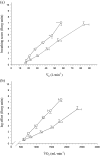The effects of exercise modality and intensity on energy expenditure and cardiorespiratory response in adults with obesity and treated obstructive sleep apnoea
- PMID: 27075360
- PMCID: PMC5729727
- DOI: 10.1177/1479972316643699
The effects of exercise modality and intensity on energy expenditure and cardiorespiratory response in adults with obesity and treated obstructive sleep apnoea
Abstract
To inform recommendations for the exercise component of a healthy lifestyle intervention for adults with obesity and treated obstructive sleep apnoea (OSA), we investigated the total energy expenditure (EE) and cardiorespiratory response to weight-supported (cycling) and unsupported (walking) exercise. Individuals with treated OSA and a body mass index (BMI) > 30 kg/m2 performed an incremental cardiopulmonary exercise test on a cycle ergometer and a treadmill to determine the peak oxygen uptake [Formula: see text]. Participants subsequently completed two endurance tests on each modality, matched at 80% and 60% of the highest [Formula: see text] determined by the incremental tests, to intolerance. The cardiorespiratory response was measured and total EE was estimated from the [Formula: see text]. Sixteen participants completed all six tests: mean [SD] age 57 [13] years and median [IQ range] BMI 33.3 [30.8-35.3] kg/m2. Total EE during treadmill walking was greater than cycling at both high (158 [101] vs. 29 [15] kcal; p < 0.001) and moderate (178 [100] vs. 85 [59] kcal; p = 0.002) intensities, respectively, with similar cardiorespiratory responses and pattern of EE during rest, exercise and recovery. Contrary to current guidelines, walking might be the preferred training modality to achieve the combination of weight loss and increased cardiorespiratory fitness in adults with obesity and treated OSA.
Keywords: Energy expenditure; exercise; obesity; obstructive sleep apnoea; weight supported; weight unsupported.
Conflict of interest statement
Figures




Similar articles
-
Do field walking tests produce similar cardiopulmonary demands to an incremental treadmill test in obese individuals with treated OSA?Chest. 2014 Jul;146(1):81-87. doi: 10.1378/chest.13-2060. Chest. 2014. PMID: 24577643 Clinical Trial.
-
Relationship between energy expenditure, physical activity and weight loss during CPAP treatment in obese OSA subjects.Respir Med. 2015 Apr;109(4):540-5. doi: 10.1016/j.rmed.2015.02.010. Epub 2015 Feb 28. Respir Med. 2015. PMID: 25769295
-
[Six-minute walk test in obstructive sleep apnoea].Pneumonol Alergol Pol. 2008;76(2):75-82. Pneumonol Alergol Pol. 2008. PMID: 18464221 Polish.
-
OSA and cardiorespiratory fitness: a review.J Clin Sleep Med. 2022 Jan 1;18(1):279-288. doi: 10.5664/jcsm.9628. J Clin Sleep Med. 2022. PMID: 34437054 Free PMC article. Review.
-
Maximal exercise capacity in patients with obstructive sleep apnoea syndrome: a systematic review and meta-analysis.Eur Respir J. 2018 Jun 28;51(6):1702697. doi: 10.1183/13993003.02697-2017. Print 2018 Jun. Eur Respir J. 2018. PMID: 29700103
Cited by
-
Exercise Increases Adiponectin and Reduces Leptin Levels in Prediabetic and Diabetic Individuals: Systematic Review and Meta-Analysis of Randomized Controlled Trials.Med Sci (Basel). 2018 Oct 30;6(4):97. doi: 10.3390/medsci6040097. Med Sci (Basel). 2018. PMID: 30380802 Free PMC article. Review.
-
The relationship between cardiorespiratory fitness and indices of fat mass and fat-free mass in adults.Front Sports Act Living. 2025 Jul 24;7:1583432. doi: 10.3389/fspor.2025.1583432. eCollection 2025. Front Sports Act Living. 2025. PMID: 40792080 Free PMC article.
-
Exercise-Induced Alternations of Adiponectin, Interleukin-8 and Indicators of Carbohydrate Metabolism in Males with Metabolic Syndrome.Biomolecules. 2023 May 18;13(5):852. doi: 10.3390/biom13050852. Biomolecules. 2023. PMID: 37238721 Free PMC article.
-
Obesity and metabolic syndrome in COPD: Is exercise the answer?Chron Respir Dis. 2018 May;15(2):173-181. doi: 10.1177/1479972317736294. Epub 2017 Nov 8. Chron Respir Dis. 2018. PMID: 29117797 Free PMC article. Review.
-
Towards Optimized Care After Bariatric Surgery by Physical Activity and Exercise Intervention: a Review.Obes Surg. 2020 Mar;30(3):1118-1125. doi: 10.1007/s11695-020-04390-x. Obes Surg. 2020. PMID: 31912467 Review.
References
-
- World Health Organisation. Available at: http://www.who.int/mediacentre/factsheets/fs311/en/index.html# (accessed 30 October 2013).
-
- Barlow CE, Kohl HW, III, Gibbons LW, et al. Physical fitness, mortality and obesity. Int J Obes Relat Metab Disord 1995; 19(Suppl 4): S41–S44. - PubMed
-
- Haskell WL, Lee IM, Pate RR, et al. Physical activity and public health: updated recommendation for adults from the American College of Sports Medicine and the American Heart Association. Circulation 2007; 116(9): 1081–1093. - PubMed
-
- Davis JN, Hodges VA, Gillham MB. Physical activity compliance: differences between overweight/obese and normal-weight adults. Obesity (Silver Spring) 2006; 14(12): 2259–2265. - PubMed
-
- West SD, Kohler M, Nicoll DJ, et al. The effect of continuous positive airway pressure treatment on physical activity in patients with obstructive sleep apnoea: a randomised controlled trial. Sleep Med 2009; 10(9): 1056–1058. - PubMed
MeSH terms
LinkOut - more resources
Full Text Sources
Other Literature Sources
Medical

